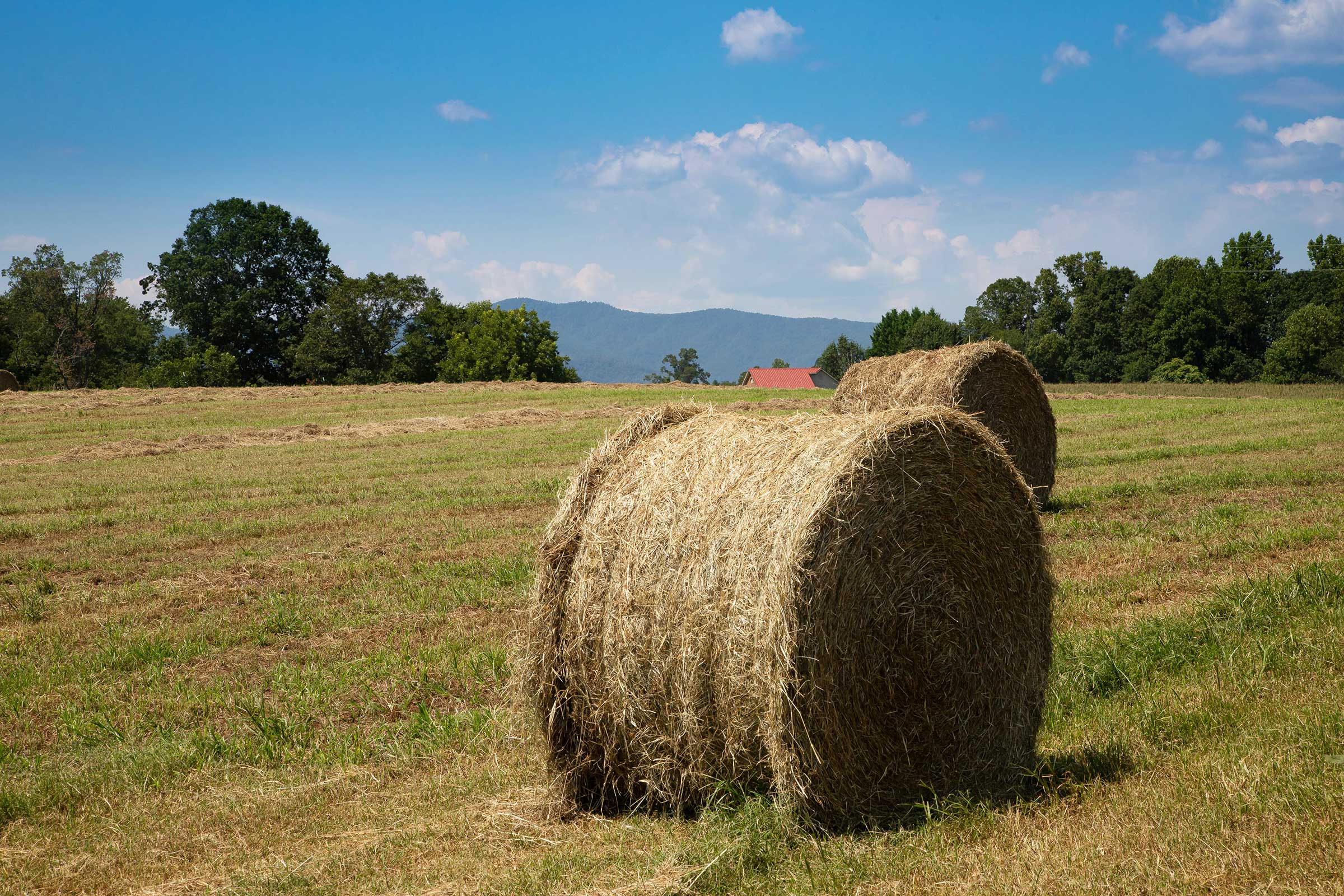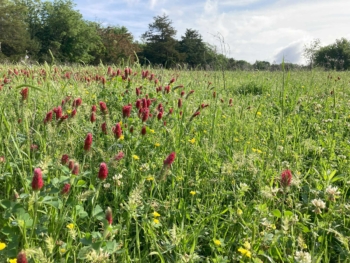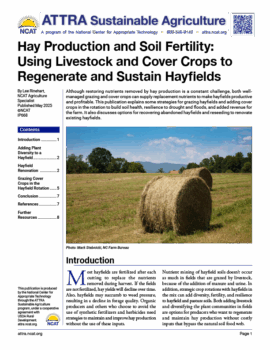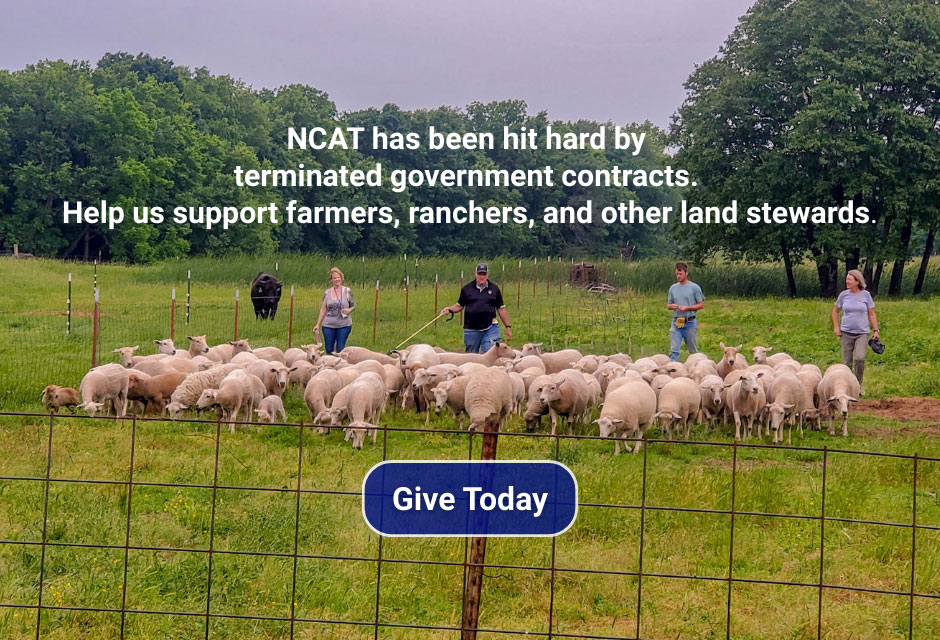Hay Production and Soil Fertility: Using Livestock and Cover Crops to Regenerate and Sustain Hayfields

Photo: Mark Stebnicki, NC Farm Bureau
By Lee Rinehart, NCAT Agriculture Specialist
Abstract
Although restoring nutrients removed by hay production is a constant challenge, both well-managed grazing and cover crops can supply replacement nutrients to make hayfields productive and profitable. This publication explains some strategies for grazing hayfields and adding cover crops in the rotation to build soil health, resilience to drought and floods, and added revenue for the farm. It also discusses options for recovering abandoned hayfields and reseeding to renovate existing hayfields.
Contents
Introduction
Adding Plant Diversity to a Hayfield
Hayfield Renovation
Grazing Cover Crops in the Hayfield Rotation
Conclusion
References
Further Resources
Introduction
Most hayfields are fertilized after each cutting to replace the nutrients removed during harvest. If the fields are not fertilized, hay yields will decline over time. Also, hayfields may succumb to weed pressure, resulting in a decline in forage quality. Organic producers and others who choose to avoid the use of synthetic fertilizers and herbicides need strategies to maintain and improve hay production without the use of these inputs.
Nutrient mining of hayfield soils doesn’t occur as much in fields that are grazed by livestock, because of the addition of manure and urine. In addition, strategic crop rotations with hayfields in the mix can add diversity, fertility, and resilience to hayfield and pasture soils. Both adding livestock and diversifying the plant communities in fields are options for producers who want to regenerate and maintain hay production without costly inputs that bypass the natural soil food web.

Photo: Nina Prater, NCAT
Adding Plant Diversity to a Hayfield
Meadows and prairies are naturally productive, due in part to the diversity of plant types and species within the plant community. If you add a more diverse plant population to your hayfields, through cover cropping and complex perennial mixes, you can build soil health and resilience. For example, you can frost seed or no-till drill legumes, such as red clover, crimson clover, or alfalfa. Or you might consider periodically rotating your hayfields to cover crops and livestock grazing to maintain fertility levels. This may necessitate managing the pastures as several separate units, to ensure hay is produced each year while part of the land is in annual cover crops and grazing to build soil health. After three to four years of diverse perennial pasture, convert the field to cover crops and graze for a year, then replant to perennial pasture in the fall for several more years of hay production.
The more diversity you can get into the fields, the better it will be for soil life. It’s a cycle where the soil organisms build soil structure and cycle nutrients, which feed the crops, and the crops provide nutrients back to the microbes. At the end of the summer of annual crops, you can go back to a fall cover crop, and then perennial hayfield the following year. This kind of rotation provides cover, reduces erosion, conserves water, buffers soil temperature, and adds organic matter while maintaining hay production without mining the soil, and it also adds a new enterprise. Producers who add cover crops and graze them can increase the profitability of their operation by selling animals or animal products.
Hayfield Renovation
When a hayfield begins to decline due to weed encroachment or lack of fertility, production also declines, and profitability suffers. When the stand begins to thin and weeds become prevalent, it may be time to renovate.
Renovation comes in many shapes and sizes, from adding new species to plowing the field and replanting. The least costly option is planting new species into existing stands. This works well when the hayfield is relatively healthy and you want to increase the quality of your forages. The decision to till the field and replant is a big one, and a costly one. Make sure you really need to renovate to this extent before bringing the tractor out of the barn.

Sorghum-sudan is a summer annual that fills a grazing gap in late summer and is a good transition to fall cover crops or a fall-planted perennial hay crop. Photo: Linda Coffey, NCAT
Livestock can be an effective management tool for renovating hayfields and pastures. Allow the hayfield to mature to seed stage with high biomass and graze with livestock that have low nutrient requirements, like dry cows. Stock at high density and move animals daily, allowing them to trample most of the forage. The high impact and mulch created by the grazing livestock will return high amounts of organic matter to the soil and kick-start the soil food web. A few grazing seasons of this treatment will result in new growth with higher quality, more diverse hayfields. For more information on grazing to renovate pastures with livestock, read ATTRA’s Pasture, Rangeland, and Adaptive Grazing.
Some other options for renovating hayfields include tilling or no-tilling summer annuals, followed by fall-planted cool-season perennials. Follow fall-planted rye and clover with summer sorghum-sudan, then cool-season perennial pasture or hayfield. For warm-season crops, fall-planted annual ryegrass and white clover can follow summer annuals, to be followed in turn by early-spring drill planting of warm-season grasses and legumes.
Renovating grass hayfields, especially by adding legumes, adds diversity, increases fertility, and optimizes forage quality. Two legumes that work well in most parts of the country are red clover and alfalfa. For planting into grass fields, a seeding rate of six to 12 pounds per acre for clovers and 12 to 20 pounds per acre for alfalfa is appropriate. Use the higher rates when broadcasting and the lower rates when drilling seed. Alfalfa and red clover are great legumes for haying, as they are tall-statured and produce more biomass than other legumes. A healthy stand of grasses and legumes can help reduce weed problems, as well, by outcompeting unwanted plants.
Before adding legumes to a hayfield, conduct a soil test in the fall and apply lime as needed to achieve a pH of around 6.5. Then, graze the hayfield hard (taking the grass down as low as possible) or mow on lowest setting in fall and winter. After that, you can frost-seed the legumes in late winter/early spring. This will allow the seeds the greatest access to the soil and ensure optimum germination.
Frost-seeding is most appropriate for small-seeded forages, such as clovers. This method works well in areas that experience a freeze-thaw pattern in the spring before green-up. Broadcast seeds around or after snowmelt and allow the natural freeze-thaw action that occurs each day to work the seed into the ground. If the timing is right, this can be an effective way to achieve seed-to-soil contact and incorporate legumes into a grass pasture. For the humid areas of the South or drier areas of the West, fall seeding of legumes allows seedlings to establish during the winter rainy season.
If legumes have been absent from your fields for a few years, plant seed with the appropriate inoculant to ensure an adequate bacterial population for nitrogen fixation. Use the strain Rhizobium leguminosarum bv. Trifolii for red clover, crimson clover, and white clover, and use Sinorhizobium meliloti for alfalfa. Purchase inoculants with your seed order and mix them with the seed prior to planting. It’s best to apply the inoculant with a sticky substance to prevent it from settling out in the seed bin. A 1-in-10 dilution of syrup or molasses, diluted cola, or milk works well as a sticking agent (Durst and Bosworth, 2025).

Stripe of crimson clover where round bales were rolled out to feed hay in winter. Photo: Prater farm, Cedarville, AR
Terminating and Replanting a Hayfield
Finally, if a complete renovation is necessary to correct deficiencies and improve productivity (evidenced by heavy weed pressure, low forage yield, and the need for better-yielding varieties), you can terminate the existing stand through tillage and replant. The first step is to test the soil and add lime to get the pH to around 6.5. Many producers and forage specialists recommend burning the stand down with an herbicide and then no-till drilling the new species into the field. For those who do not wish to use herbicides, a few tillage events to remove regrowth and harrowing to get a clean seedbed are crucial.
Choose species that are adapted to your area. For the southern United States, choices include tall fescue, bermudagrass, bahaigrass, white clover, red clover, and alfalfa. In the northeastern United States, orchardgrass, red clover, and alfalfa do well. The Intermountain West also has some adapted species, including meadow brome and alfalfa. Regardless of where you are, you can find good information on species selection and seeding rates from your state Extension service. Once you’ve chosen your seed mix, use a Brillion seed drill to plant the seeds to a depth of around ¼ inch or increase the seeding rate and broadcast seed, then pack the soil with a corrugated roller to ensure seed-to-soil contact. Forage seeds need adequate soil moisture for the first 30 to 40 days after planting to ensure germination, emergence, and a good stand.
Management of Newly Renovated Hayfields
One problem many producers encounter when planting legumes into a grass stand is competition. The grasses have an established root system and will easily outcompete the legumes if the producer does not intervene. There are a few tricks you can use to ensure the grass does not overtake and outcompete the new legume seedlings (Lacefield and Smith, 2009):
- Do not apply nitrogen if the plant composition is greater than 25% legumes, to prevent grasses from outcompeting legumes.
- Use the proper seeding rate and inoculation for the legumes at planting.
- Drill or broadcast (after a light disc) seed and then pack the soil, for good seed-to-soil contact. Discing and broadcasting in the spring suppresses the grasses better than no-till drilling, to allow the legumes to establish. Another option is to frost-seed in late winter. The grass will need to be grazed heavily or mowed low prior to frost-seeding, to allow the seeds to obtain soil contact.
- If weeds become an issue, mow the grasses until the legumes are about four inches tall.
Restoring Abandoned Hayfields

Photo: Lee Rinehart, NCAT
In some areas of the country (with adequate rainfall), tall forbs and woody species emerge in abandoned fields that have not been mowed or grazed. Plant succession will tend to transform the field into a forest. If left to nature’s elements, these fields will reach their climax stage of hardwood forest in 100 to 150 years. Reverting forests back to hayfields can be an expensive and laborious process. In this case, selective cutting and strategic reseeding can convert the land into a silvopasture.
If woody species are sparse, mowing the field three or four times a year, with lime and application of manure or compost annually, can improve a field in about three years. If saplings and young trees have encroached, and depending on how thick the stands are, there are several ways to move forward, from using a chainsaw or a rotary mower, to using a chain pulled behind a tractor or a dozer to move woody material into piles for burning or chipping. Reseeding may be necessary, or turn livestock into the field for two to three years and rotate them according to good management practices to allow enough rest for new species to emerge and become established.
Grazing Cover Crops in the Hayfield Rotation
Grazing can be an important way to get carbon into the soil and inoculate the soil with microorganisms that reside in and on livestock. Livestock will tramp uneaten plants into the soil, feeding organic matter to the microorganisms. You will need enough animals and enough density to make this happen. Questions to consider include:
- How many animals do you currently have?
- Can you get enough animals on the land to graze around 50% of the cover crop and leave the rest on the soil surface as residue?
- Can you use polywire to subdivide the field and be more strategic with the grazing period and recovery period?
- Where is your water source, or can you move a portable water tank to each paddock throughout the grazing rotation?
- Do you have a paddock to use when the pasture is too wet to graze? High animal density on wet pastures can cause soil compaction, though in a well-managed, healthy pasture the effects of compaction can be corrected within a year (Blanco-Canqui et al., 2023).
You can set back perennial fields prior to no-tilling cover crops by grazing them hard, but it may require tillage to seed successfully, especially if you’re thinking about summer annual cover crops like sorghum-sudan. The problem with trying to incorporate a cover into an existing pasture is plant competition. You will have to experiment to find the best strategy. Follow the summer season with a fall cover of rye and perhaps a brassica and maybe a fall legume or two that can be terminated by grazing the next spring. Graze the planting and trample two-thirds of the biomass while consuming one-third. This puts carbon back into the soil.
A Note about Using Nitrogen Fertilizer
Early applications of inorganic nitrogen can increase first-cutting yields if available soil phosphorus and potassium levels are adequate. This is a quick-fix solution that bypasses the soil food web and generally results in reduced soil health. Organic farmers are limited to fertilizers that are organic, and these need microbial activity to mineralize the nitrogen and make it available to the plants. A field with at least 30% legumes can provide the nitrogen needed to maintain stand productivity.
In the meantime, you may have to fertilize or apply compost or manure to keep forage production up on the hayfields that you are not cover-cropping. If you graze them, use a stocking density of at least 100,000 pounds of live animals per acre and allow full pasture recovery before the next grazing period (no more than four days for each grazing event) and wait for sufficient recovery (30 days or more, depending on soil moisture) until grazing pastures again. Pastures must fully recover before subsequent grazing. See the ATTRA blog “Adaptive Grazing – You Can Do It” (attra.ncat.org/adaptive-grazing-you-can-do-it) for details on pasture soil fertility, health, and grazing ideas.
Think about the resources you have or need to plant and graze cover crops:
- Do you have access to the necessary machinery to till the soil, incorporate manure, and plant a diverse cover crop? Can you barter or rent equipment?
- Can you put enough animals on the pastures to graze the fields efficiently?
- Is your fencing up to par? Can you use temporary fencing to divide the fields and rotate animals based on plant recovery time?
You should do an economic analysis of your options. You know the costs of the fertilizers, so you can add to that the cost of application and harvesting. Compare this to several probable hay yields and see where your break-even point lies. Then, assess your costs for cover crops and grazing. Get costs for:
- Tillage
- Seeds
- Lime
- Planting
- Fencing
- Cost of animals (you may be able to custom graze or allow a neighbor to graze your fields. For more information see ATTRA’s Grazing Contracts for Livestock, available at attra.ncat.org/publication/grazing-contracts-for-livestock).
Finally, do an economic projection of costs vs. animals sold and hay produced over the next three to five years as the soil heals itself. These are not easy recommendations, and it will take some resources to get them done effectively. You can either spend less money on the tools for cover crops and grazing, or more for adding fertilizers.
Rotation Considerations
Hayfields can be incorporated into long crop rotations. At any given time, some fields can be in perennial pasture, some in perennial hayfield, and others in grazed cover crops.The rotation for any management unit could look like this:
Perennial pasture (hayed every other year) > one season or year in cover crop (grazed) > perennial pasture/hayland
The fallow ground follows this rotation:
Summer cover crop > fall cover crop > seed to perennial pasture
Some of the questions you will need to answer to refine the system include:
- How much hay do you feed or sell in a year?
- Can you buy hay and graze all your pastureland? This can work if you stockpile forage and graze further into the winter. You can significantly reduce your costs by making your grazing season longer.
- Do you have a realistic figure for how much hay is costing you, including depreciation on any haying equipment? Look at your whole operation to see where your money is going. You will be able to reduce a lot of hay expense by calving later, when the grass is lush, and grazing stockpiled hay through the winter.
Haying is often profitable, but has two big drawbacks:
- True cost is way more than we realize (equipment, fertilizer, nutrient loss, weed management, etc.)
- Often, haying does not allow for soil regeneration, only degradation, which adds to your cost.
It may seem daunting to make the shift to grazing or cover-cropping hayfields, but you don’t have to do it all at once. If you decide to make the shift, it is best to do it in increments and with a thorough cash-flow examination.
Conclusion
If your goals are to raise hay and livestock, develop a soil health plan first. Concentrate on building soils with cover crops and grazing, and rotate fields out for hay production so you always have several fields in this enterprise. Your hay and livestock enterprises will complement each other, and you can think of them as the benefits of your soil health plan.
You might have to spend some money to get your hayfields back in order, but you have options: the input method (fertilizers) or a method that adds biological diversity and changes the system over time. A third option would be to apply some needed fertilizers the first year, as well as compost and/or manure, and work thereafter to incorporate cover crops into the system and graze them.
Finally, think about your production system and what you want to get out of it. Hay production seriously mines the soil and removes nutrients that will never get replaced unless you buy expensive inputs. Grazing, however, is less extractive when managed right, and the benefits of diverse cover crops, are healthier soil and more productivity over time.
References
Blanco-Canqui, Humberto, Karla Wilke, Johnathon Holman, Cody F. Creech, Augustine K. Obour, and Lindsey Anderson. 2023. Grazing cover crops: How does it influence soils and crops? Agronomy Journal. Vol. 115. p.2801–2828. acsess.onlinelibrary.wiley.com/doi/10.1002/agj2.21475
Durst, Phillip, and Sidney Bosworth. 2025. Inoculation of Forage and Grain Legumes. Penn State Extension. extension.psu.edu/inoculation-of-forage-and-grain-legumes
Lacefield, G.D., and S. Ray Smith. 2009. Renovating Hay and Pasture Fields. University of Kentucky Cooperative Extension. forages.ca.uky.edu/files/agr26.pdf
Further Resources
7 Ways of Comparing Conventional vs Organic Hay That Impact Animal Health. 2025. FarmstandApp.
Forage Facts: This Old Hayfield: A Fact Sheet on Hayfield Renovation. 2024. By Rick Kersbergen, University of Maine Cooperative Extension.
Lessons from a Study on Hay Variability: Insights for Organic Producers. 2024. By Bob Whitney. Texas A&M AgriLife Extension.
Low-Cost Seeding Methods for Improving Pastures and Haylands. 2018. By Rich Taber. Cornell Small Farms Program.
Organic Alfalfa Management Guide. 2009. By E. Patrick Fuerst, Richard T. Koenig, John Kugler, Kathleen Painter, Mark Stannard, and Jessica Goldberger. Washington State University Extension.
Revitalizing Old Fields for Pasture and Hay. 2006. By Diane Schivera. Maine Organic Farmers and Gardeners.
Hay Production and Soil Fertility: Using Livestock and Cover Crops to Regenerate and Sustain Hayfields
By Lee Rinehart, NCAT Agriculture Specialist
May 2025
© NCAT
IP668
This publication is produced by the National Center for Appropriate Technology through the ATTRA Sustainable Agriculture program, under a cooperative agreement with USDA Rural Development. ATTRA.NCAT.ORG


